Module 18 - Radar PrinciplesPages
i,
1-1, 1-11,
1-21,
1-31,
1-41,
2-1,
2-11,
2-21,
2-31,
2-41,
3-1,
3-11,
3-21,
4-1,
4-11,
4-21,
AI-1,
AII-1,
Index-1 to 3
Chapter 2
Radar Subsystems
Learning Objectives
Upon completion of this chapter, the student will be able to:
1. Describe, in general terms, the function of a radar synchronizer.
2. State the basic requirements and types of master synchronizers.
3. Describe the purpose, requirements, and operation of a radar modulator.
4. Describe the basic operating sequence of a keyed-oscillator transmitter.
5. Describe the basic operating sequence of a power-amplifier transmitter.
6. State the purpose of a duplexer.
7. State the operational principles of TR and ATR tubes.
8. Describe the basic operating sequence of series and parallel connected duplexers.
9. List the basic design requirements of an effective radar receiver.
10. List the major sections of a typical radar receiver.
11. Using a block diagram, describe the operational characteristics of a typical
radar receiver.
Introduction to Radar Subsystems
Any radar system has several major subsystems that perform standard functions.
a typical radar system consists of a Synchronizer (also called the TIMER or TRIGGER
GENERATOR), a Transmitter, a DUPLEXER, a RECEIVER, and an INDICATOR. These major
subsystems were briefly described in chapter 1. This chapter will describe the operation
of the synchronizer, transmitter, duplexer, and receiver of a typical pulse radar
system and briefly analyze the circuits used. Chapter 3 will describe typical indicator
and antenna subsystems. Because radar systems vary widely in specific design, only
a general description of representative circuits is presented in this chapter.
Synchronizers
The synchronizer is often referred to as the "heart" of the radar system because
it controls and provides timing for the operation of the entire system. Other names
for the synchronizer are the TIMER and the KEYER. We will use the term synchronizer
in our discussion. In some complex systems the synchronizer is part of a system
computer that performs many functions other than system timing.
2-1
Synchronizer Function
The specific function of the synchronizer is to produce TRIGGER PULSES that start
the transmitter, indicator sweep circuits, and ranging circuits.
Timing or control is the function of the majority of circuits in radar. Circuits
in a radar set accomplish control and timing functions by producing a variety of
voltage waveforms, such as square waves, sawtooth waves, trapezoidal waves, rectangular
waves, brief rectangular pulses, and sharp peaks. Although all of these circuits
can be broadly classified as timing circuits, the specific function of any individual
circuit could also be wave shaping or wave generation. The operation of many of
these circuits and associated terms were described in detail in NEETS, Module 9,
Introduction to Wave-Generation and Wave-Shaping Circuits.
Q1. What is the purpose of the synchronizer in a radar system?
Q2. What is the purpose of the majority of circuits in a radar system?
Synchronizer Operation
Radar systems may be classified as either SELF-SYNCHRONIZED or EXTERNALLY SYNCHRONIZED
systems. In a self-synchronized system, the timing trigger pulses are generated
in the transmitter. In an externally synchronized system, the timing trigger pulses
are generated by a MASTER Oscillator, which is usually external to the transmitter.
The master oscillator in an externally synchronized system may be a BlockING
Oscillator, a SINE-WAVE Oscillator, or an ASTABLE (FREE-RUNNING) MULTI-VIBRATOR.
When a blocking oscillator is used as a master oscillator, the timing trigger pulses
are usually obtained directly from the oscillator. When a sine-wave oscillator or
an astable multivibrator is used as a master oscillator, pulse-shaping circuits
are required to form the necessary timing trigger pulses. In an externally synchronized
radar system, the pulse repetition rate (prr) of the timing trigger pulses from
the master oscillator determines the prr of the transmitter.
In a self-synchronized radar system, the prr of the timing trigger pulses is
determined by the prr of the modulator or transmitter.
Associated with every radar system is an indicator, such as a cathode-ray tube,
and associated circuitry. The indicator can present range, bearing, and elevation
data in visual form so that a detected object may be located. Trigger pulses from
the synchronizer are frequently used to produce gate (or enabling) pulses. When
applied to the indicator, gate pulses perform the following functions:
1. Initiate and time the duration of the indicator sweep voltage
2. Intensify the cathode-ray tube electron beam during the sweep period so that
the echo pulses may be displayed
3. Gate a range marker generator so that range marker signals may be superimposed
on the indicator presentation
Figure 2-1 shows the time relationships of the various waveforms in a typical
radar set. The timing trigger pulses are applied to both the transmitter and the
indicator. When a trigger pulse is applied to the transmitter, a short burst of
transmitter pulses (rf energy) is generated.
2-2
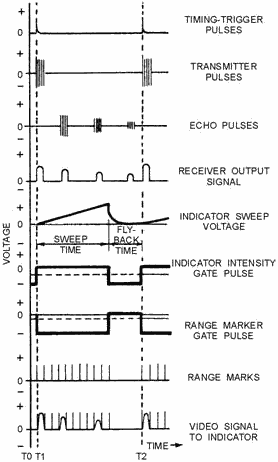
Figure 2-1. - Time relationship of waveforms.
This energy is conducted along a transmission line to the radar antenna. It is
radiated by the antenna into space. When this transmitter energy strikes one or
more reflecting objects in its path, some of the transmitted energy is reflected
back to the antenna as echo pulses. Echo pulses from three reflecting targets at
different ranges are illustrated in figure 2-1. These echoes are converted to the
corresponding receiver output signals as shown in the figure. The larger initial
and final pulses in the receiver output signal are caused by the energy that leaks
through the duplexer when a pulse is being transmitted.
The indicator sweep voltage shown in figure 2-1 is initiated at the same time
the transmitter is triggered. In other applications, it may be more desirable to
delay the timing trigger pulse that is to be fed to the indicator sweep circuit.
Delaying the trigger pulse will initiate the indicator sweep after a pulse is transmitted.
Note in figure 2-1 that the positive portion of the indicator intensity gate
pulse (applied to the cathode-ray tube control grid) occurs only during the indicator
sweep time. As a result, the visible
2-3
cathode-ray tube trace occurs only during sweep time and is eliminated during
the flyback (retrace) time. The negative portion of the range-marker gate pulse
also occurs during the indicator sweep time. This negative gate pulse is applied
to a range-marker generator, which produces a series of range marks.
The range marks are equally spaced and are produced only for the duration of
the range-marker gate pulse. When the range marks are combined (mixed) with the
receiver output signal, the resulting video signal applied to the indicator may
appear as shown at the bottom of figure 2-1.
Q3. a self-synchronized radar system obtains timing trigger pulses from what
source?
Q4. What type of multivibrator can be used as a radar master oscillator?
Q5. In an externally synchronized radar, what determines the prr of the transmitter?
Q6. In figure 2-1, what causes the initial and final pulses on the receiver output
signal?
Basic Synchronizer Circuits
The basic synchronizer circuit should meet the following three basic requirements:
1. It must be free running (astable). Because the synchronizer is the heart of
the radar, it must establish the zero time reference and the PRF (prr).
2. It should be stable in frequency. For accurate ranging, the prr and its reciprocal,
pulse-repetition time (prt), must not change between pulses.
3. The frequency must be variable to enable the radar to operate at different
ranges.
Three basic synchronizer circuits can meet the above mentioned requirements.
They are the SINE- WAVE Oscillator, the Single-SWING BlockING Oscillator, and the
MASTER- TRIGGER (ASTABLE) MULTIVIBRATOR.
Figure 2-2 shows the block diagrams and waveforms of these three synchronizers
as they are used in externally synchronized radar systems. In each case, equally
spaced timing trigger pulses are produced. The prr of each series of timing trigger
pulses is determined by the operating frequency of the associated master oscillator.
2-4
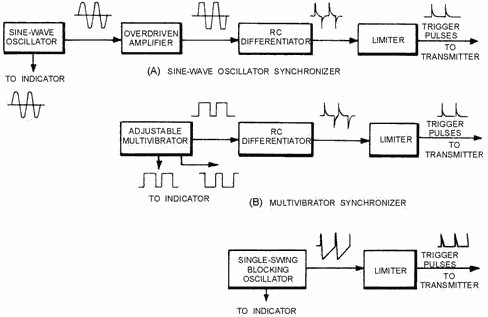
Figure 2-2. - Timers used in externally synchronized radar systems.
Sine-Wave Oscillator Synchronizer
In the sine-wave oscillator synchronizer (figure 2-2, view A), a sine-wave oscillator
is used for the basic timing device (master oscillator). The oscillator output is
applied to both an overdriven amplifier and the radar indicator. The sine waves
applied to the overdriven amplifier are shaped into square waves. These square waves
are then converted into positive and negative timing trigger pulses by means of
a short-time-constant RC differentiator.
By means of a limiter, either the positive or negative trigger pulses from the
RC differentiator are removed. This leaves trigger pulses of only one polarity.
For example, the limiter in view a of figure 2-2 is a negative-lobe limiter; that
is, the limiter removes the negative trigger pulses and passes only positive trigger
pulses to the radar transmitter.
A disadvantage of a sine-wave oscillator synchronizer is the large number of
pulse-shaping circuits required to produce the necessary timing trigger pulses.
Master Trigger (Astable) Multivibrator Synchronizer
In a master trigger (astable) multivibrator synchronizer (view B, figure 2-2),
the master oscillator generally is an astable multivibrator. The multivibrator is
either ASYMMETRICAL or SYMMETRICAL. If the multivibrator is asymmetrical, it generates
rectangular waves. If the multivibrator is symmetrical, it generates square waves.
In either case, the timing trigger pulses are equally spaced after a limiter removes
undesired positive or negative lobes.
2-5
There are two transistors in an astable multivibrator. The two output voltages
are equal in amplitude, but are 180 degrees out of phase. The output of the astable
multivibrator consists of positive and negative rectangular waves. Positive rectangular
waves are applied to an RC differentiator and converted into positive and negative
trigger pulses. As in the sine-wave synchronizer, the negative trigger pulses are
removed by means of a negative-lobe limiter, and the positive pulses are applied
to the transmitter.
Both positive and negative rectangular waves from the astable multivibrator are
applied to the indicator. One set of waves is used to intensify the cathode-ray
tube electron beam for the duration of the sweep. The other set of waves is used
to gate (turn on) the range marker generator.
Single-Swing Blocking Oscillator Synchronizer
In the single-swing, blocking-oscillator synchronizer, shown in view C of figure
2-2, a free-running, single-swing blocking oscillator is generally used as the master
oscillator. The advantage of the single- swing blocking oscillator is that it generates
sharp trigger pulses without additional shaping circuitry. Timing trigger pulses
of only one polarity are obtained by means of a limiter.
Gating pulses for the indicator circuits are produced by applying the output
of the blocking oscillator to a one-shot multivibrator or another variable time
delay circuit (not shown). Crystal-controlled oscillators may be used when very
stable frequency operation is required.
Q7. What basic circuits meet the requirements of an externally synchronized master
oscillator?
Q8. Name a disadvantage of sine-wave oscillator synchronizers.
Q9. Which of the basic timing circuits produces sharp trigger pulses directly?
Transmitters
The Transmitter produces the short duration high-power RF pulses of energy that
are radiated into space by the antenna. Two main types of transmitters are now in
common use. The first is the KEYED-Oscillator type. In this transmitter one stage
or tube, usually a magnetron, produces the RF pulse. The oscillator tube is keyed
by a high-power dc pulse of energy generated by a separate unit called the Modulator
(discussed in the following section). The second type of transmitter consists of
a Power-Amplifier CHAIN. This transmitter system begins with an RF pulse of very
low power. This low-level pulse is then amplified by a series (chain) of power amplifiers
to the high level of power desired in a transmitter pulse. In most power-amplifier
transmitters, each of the power-amplifier stages is pulse modulated in a manner
similar to the oscillator in the keyed-oscillator type. Because the modulator is
common to both types of transmitter systems, the operation of a typical modulator
will be discussed first.
Radar Modulator
The modulator controls the radar pulse width by means of a rectangular dc pulse
(modulator pulse) of the required duration and amplitude. The peak power of the
transmitted RF pulse depends on the amplitude of the modulator pulse.
Figure 2-3 shows the waveforms of the trigger pulse applied by the synchronizer
to the modulator, the modulator pulse applied to the radar transmitter, and the
transmitted RF pulse.
2-6
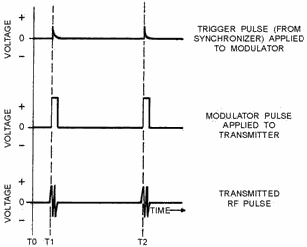
Figure 2-3. - Transmitter waveforms.
As you can see in the figure, the modulator pulse is applied to the transmitter
the instant the modulator receives the trigger pulse from the synchronizer (T1,
T2). The modulator pulse is flat on top and has very steep leading and trailing
edges. These pulse characteristics are necessary for the proper operation of the
transmitter and for the accurate determination of target range. The range timing
circuits must be triggered the instant the leading edge of the transmitted RF pulse
leaves the transmitter. In this way, the trigger pulse that controls the operation
of the modulator also synchronizes the cathode-ray tube sweep circuits and range
measuring circuits.
MAGNETRON Oscillators are capable of generating RF pulses with very high peak
power at frequencies ranging from 600 to 30,000 megahertz. However, if its cathode
voltage changes, the magnetron oscillator shifts in frequency. To avoid such a frequency
change, you must ensure that the amplitude of the modulator (dc) pulse remains constant
for the duration of the transmitted RF pulse. That is, the modulator pulse must
have a flat top. The range of cathode voltages over which a magnetron oscillates
in the desired frequency spectrum is relatively small.
When a low voltage is applied to a magnetron, the magnetron produces a noise
voltage output instead of oscillations. If this noise enters the receiver, it can
completely mask the returning echoes. If a modulator pulse builds up and decays
slowly, noise is produced at both the beginning and end of the pulse. Therefore,
for efficient radar operation, a magnetron requires a modulator pulse that has a
flat top and steep leading and trailing edges. An effective modulator pulse must
perform in the following manner:
• Rise from zero to its maximum value almost instantaneously
• Remain at its maximum value for the duration of the transmitted RF pulse
• Fall from its maximum value to zero almost instantaneously
In radars that require accurate range measurement, the transmitted RF pulse must
have a steep leading edge. The leading edge of the echo is used for range measurement.
If the leading edge of the echo is not steep and clearly defined, accurate range
measurement is not possible. The leading and trailing edges of echoes have the same
shape as the leading and trailing edges of the transmitted RF pulse.
2-7
A transmitted RF pulse with a steep trailing edge is essential for the detection
of objects at short ranges. If the magnetron output voltage drops gradually from
its maximum value to zero, it contributes very little to the usable energy of the
transmitted RF pulse. Furthermore, part of the magnetron output voltage enters the
receiver and obscures nearby object echoes.
Types of Modulators
The two types of modulators are the LINE-PULSING Modulator and the HARD-TUBE
Modulator. (A hard tube is a high-vacuum electron tube.) The line-pulsing modulator
stores energy and forms pulses in the same circuit element. This element is usually
the pulse-forming network. The hard-tube modulator forms the pulse in the driver;
the pulse is then amplified and applied to the modulator. The hard tube modulator
has been replaced by the line-pulsed modulator in most cases. This is because the
hard-tube modulator has lower efficiency, its circuits are more complex, a higher
power supply voltage is required, and it is more sensitive to voltage changes.
The line-pulsing modulator is easier to maintain because of its less complex
circuitry. Also, for a given amount of power output, it is lighter and more compact.
Because it is the principally used modulator in modern radar, it is the only type
that will be discussed.
Figure 2-4 shows the basic sections of a radar modulator. They are as follows:
• The power supply.
• The storage element (a circuit element or network used to store energy).
• The charging impedance (used to control the charge time of the storage element
and to prevent short-circuiting of the power supply during the modulator pulse).
• The modulator switch (used to discharge the energy stored by the storage element
through the transmitter oscillator during the modulator pulse).
2-8
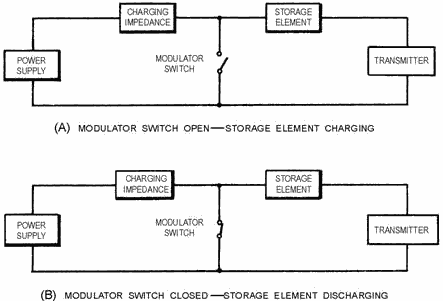
Figure 2-4. - Basic line-pulsing modulator block diagram.
View a of figure 2-4 shows the modulator switch open and the storage element
charging. With the modulator switch open, the transmitter produces no power output,
but the storage element stores a large amount of energy. View B shows the modulator
switch closed and the storage element discharging through the transmitter. The energy
stored by the storage element is released in the form of a high-power, dc modulator
pulse. The transmitter converts the dc modulator pulse to an RF pulse, which is
radiated into space by the radar antenna. Thus, the modulator switch is closed for
the duration of a transmitted RF pulse, but open between pulses.
Many different kinds of components are used in radar modulators. The power supply
generally produces a high-voltage output, either alternating or direct current.
The charging impedance may be a resistor or an inductor. The storage element is
generally a capacitor, an artificial transmission line, or a pulse-forming network.
The modulator switch is usually a thyratron.
Modulator Storage Element
Capacitor storage elements are used only in modulators that have a dc power supply
and an electron- tube modulator switch.
The capacitor storage element is charged to a high voltage by the dc power supply.
It releases only a small part of its stored energy to the transmitter. The electron-tube
modulator switch controls the charging and discharging of the capacitor storage
element.
The artificial transmission line storage element, shown in view a of figure 2-5,
consists of identical capacitors (C) and inductors (L) arranged to simulate sections
of a transmission line. The artificial transmission line serves two purposes: (1)
to store energy when the modulator switch is open (between
2-9
transmitted RF pulses) and (2) to discharge and form a rectangular dc pulse (modulator
pulse) of the required duration when the modulator switch is closed.
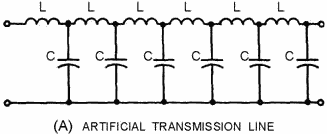
Figure 2-5A. - Modulator storage elements.
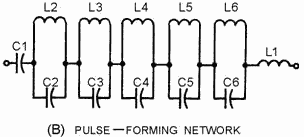
Figure 2-5B. - Modulator storage elements.
The duration of the modulator pulse depends on the values of inductance and capacitance
in each LC section of the artificial transmission line in view a and the number
of LC sections used. Other arrangements of capacitors and inductors (such as the
pulse-forming network shown in view B) are very similar in operation to artificial
transmission lines.
ARTIFICIAL Transmission Lines and PULSE-forMING NetworkS (pfn) are used more
often than the capacitor-type storage elements.
ARTIFICIAL Transmission LINE. - Figure 2-6 shows a radar modulator that uses
an artificial transmission line as its storage element. a modulator switch controls
the pulse-repetition rate. When the modulator switch is open (between transmitted
RF pulses), the transmission line charges.
2-10
| - |
Matter, Energy,
and Direct Current |
| - |
Alternating Current and Transformers |
| - |
Circuit Protection, Control, and Measurement |
| - |
Electrical Conductors, Wiring Techniques,
and Schematic Reading |
| - |
Generators and Motors |
| - |
Electronic Emission, Tubes, and Power Supplies |
| - |
Solid-State Devices and Power Supplies |
| - |
Amplifiers |
| - |
Wave-Generation and Wave-Shaping Circuits |
| - |
Wave Propagation, Transmission Lines, and
Antennas |
| - |
Microwave Principles |
| - |
Modulation Principles |
| - |
Introduction to Number Systems and Logic Circuits |
| - |
- Introduction to Microelectronics |
| - |
Principles of Synchros, Servos, and Gyros |
| - |
Introduction to Test Equipment |
| - |
Radio-Frequency Communications Principles |
| - |
Radar Principles |
| - |
The Technician's Handbook, Master Glossary |
| - |
Test Methods and Practices |
| - |
Introduction to Digital Computers |
| - |
Magnetic Recording |
| - |
Introduction to Fiber Optics |
| Note: Navy Electricity and Electronics Training
Series (NEETS) content is U.S. Navy property in the public domain. |
|














